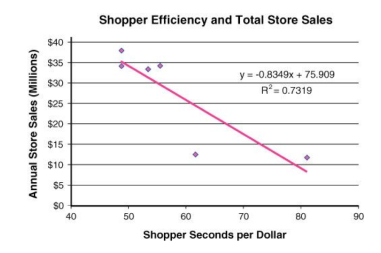Most of us have heard of this little puzzle in retail analytics: Assuming we know products A and B are usually purchased together from market basket analysis, how do we place them on shelves to maximise sales?
The often-stated “sophisticated” answer is that A and B should be placed far away from each other because that would “force” shoppers looking for both A and B to spend more time navigating the store and increase the chance of them being exposed to more products and buying more. Indeed, many retail stores devise quite deliberate strategies to keep shoppers in store for as long as possible for the precise same reason.
But is that correct?
Herb Sorensen’s shopper vision research, which is summarised in the fascinating book Inside the Mind of the Shopper published by Prentice Hall, apparently shows that total store sales is positively correlated with shopper efficiency (how fast they spend money) and the following diagram is presented to support the argument.
In the diagram, Shopper Seconds per Dollar is simply total time spent shopping divided by total sales amount in one shopping trip and it is shown that stores with longer average Shopper Seconds per Dollar have lower sales.
Two plausible explanations are offered for this empirical observation:
- Shopper vision research shows that shoppers don’t pay much attention to products while they are in navigation mode looking for what they want.
- Keeping shoppers in a store unnecessarily long may boost short-term sales but this may come at a long-term cost in that the store may be associated with unpleasant shopping experience over time.
So that’s one theory.
Without putting cameras on shoppers and sending research assistants to follow and observe how shoppers behave in practice, I don’t have the data to either corroborate or refute Sorensen’s claims. However, I have spoken to retail executives in the past and apparently they think the jury is still out on this one and pointed to the existence of research that show conflicting conclusions.
My own take on the product-placement puzzle is that it really depends on what A and B is. Specifically, who usually buys them.
In retail, we generally distinguish between two types of shoppers: those on quick-trips to satisfy an immediate need, and those on stock-up trips to replenish their weekly/fortnightly supplies. A central inconsistency in retail is that even though we know more than half of all shopping trips are quick trips that result in the purchase of five or less items, most stores are designed with stock-up shoppers in mind. The suggestion to put two related products as far away as possible is quite likely another manifestation of this phenomenon.
So what then is the right approach? I think the answer depends on whether the products A and B tend to be purchased by Quick-trippers or Stock-up shoppers. In the former case, A and B needs to be put next to each other. In the latter case, they should be placed far apart.

My personal opinion and experience, anecdotal at best, place products A and B where you want but keep it constant/ consistent. I oscillate between quick and stock up shopper. As a quick shopper, it helps me if I know where exactly is A and B. this way you create habits/same-behaviour for the shopper and the shopper becomes agnostic to price variations
LikeLike